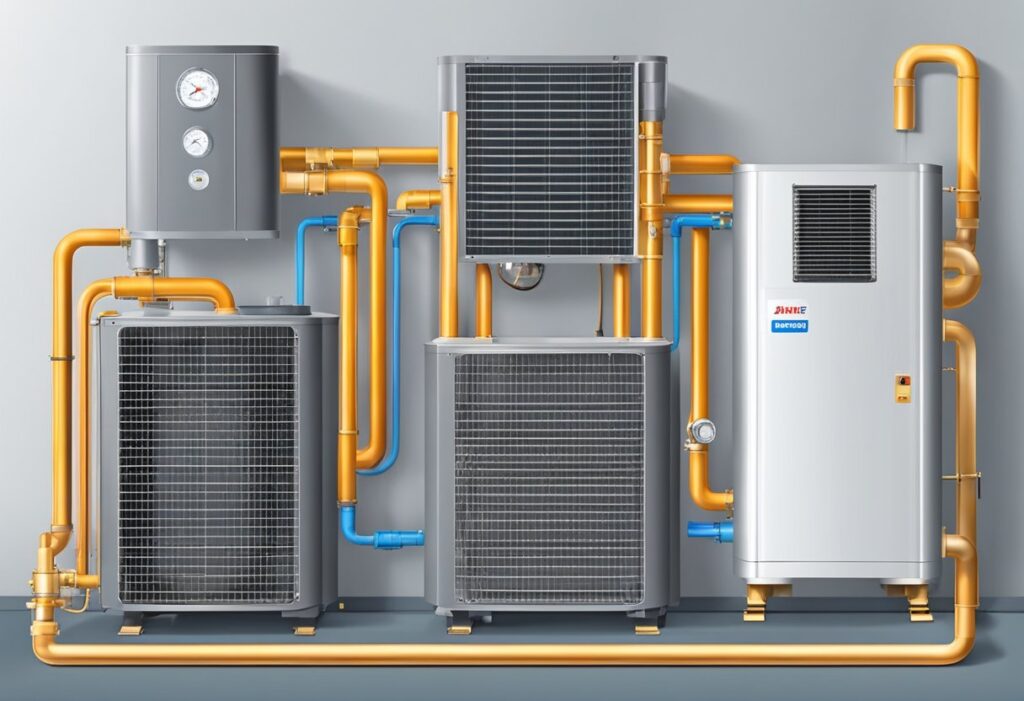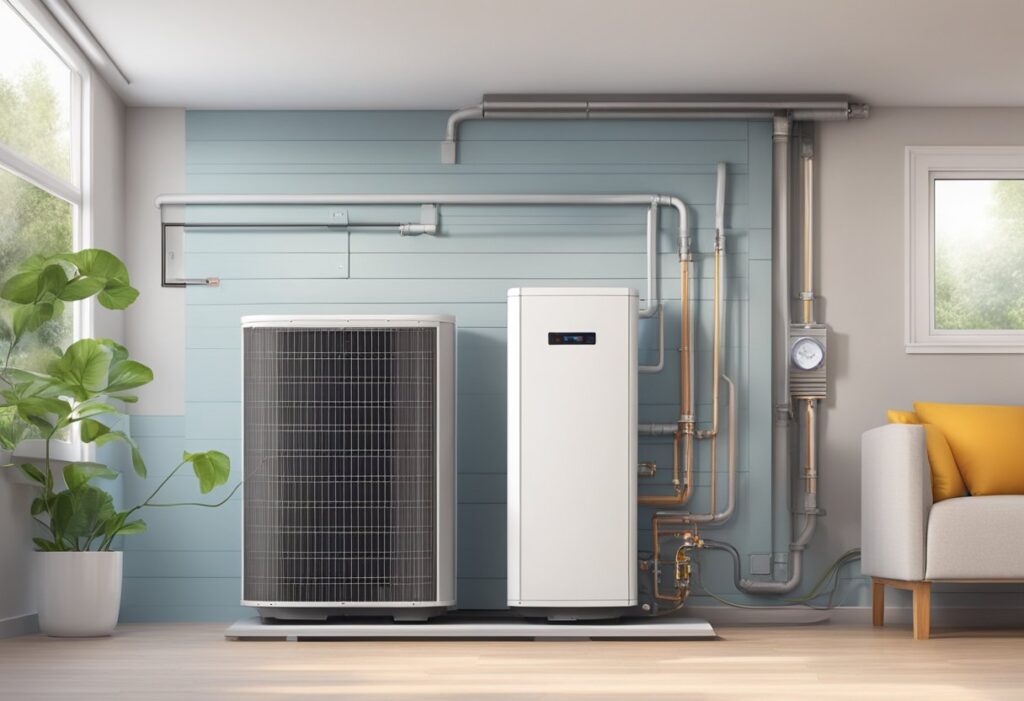In exploring heat pump technology, we aim to grasp how these systems operate, identify their different types, and unfold the process of the refrigeration cycle they rely on.

Heat pumps are devices that transfer thermal energy from one location to another, typically using it to heat or cool a building efficiently. They operate on the principle that heat naturally moves from warmer to cooler spaces.
Types of Heat Pumps
Several types of heat pumps are utilized depending on the heat source and the application:
- Air-Source Heat Pump (ASHP):.
- Ground-Source Heat Pump (GSHP) or Geothermal: Harnesses heat from the ground.
- Water Source Heat Pump: Draws heat from a nearby water source.
- Exhaust Air Heat Pump: Uses heat extracted from the indoor air being vented out.
| Type | Source of Heat | Typical Usage |
| Air-Source Heat Pump | Extracts heat from the air | Residential & Commercial |
| Ground-Source/Geothermal Heat Pump | Harnesses heat from the ground | Residential & Commercial |
| Water Source Heat Pump | Draws heat from a nearby water source | Commercial & Industrial |
| Exhaust Air Heat Pump | Uses heat extracted from the indoor air | Residential |
Refrigeration Cycle Explained
We observe that heat pumps work using a refrigeration cycle, which involves four main components:
- Evaporator: Absorbs heat into the refrigerant, causing it to evaporate.
- Compressor: Pumps the refrigerant gas, raising its pressure and temperature.
- Condenser: Releases the absorbed heat to the outside, and the refrigerant condenses back into a liquid.
- Expansion Valve: Reduces the pressure of the refrigerant, cooling it down before it re-enters the evaporator.
Refrigeration Cycle Steps:
- Low-pressure liquid refrigerant enters the evaporator.
- Heat from the source (air, ground, water) is absorbed, turning it into gas.
- The compressor increases the gas’s pressure, raising its temperature.
- High-pressure hot gas moves to the condenser, transfers heat to the outside, turns into a high-pressure liquid.
- Liquid passes through an expansion valve where pressure drops, cooling occurs, and the cycle repeats.
By employing this cycle, heat pumps can provide heating and cooling solutions in an array of environments, offering a flexible and environmentally-friendly option for temperature regulation.
Heat Pump Components and Functions
In this section, we discuss how a heat pump operates through its core components, focusing on the critical role each plays in heating and cooling cycles.
Compressor and Condenser Units
The compressor is a key component in a heat pump system; it pressurizes the refrigerant, increasing its temperature. This hot refrigerant then flows to the condenser, where it releases its heat to the surrounding environment. During this process, the refrigerant changes from a gas to a liquid. A fan aids in dispersing the heat away from the unit, facilitating efficient heat transfer.
- Compressor: Elevates refrigerant pressure and temperature.
- Condenser: Discharges heat, changes refrigerant to liquid.
- Fan: Enhances heat dispersion from the condenser.
Expansion Valve and Evaporator
Behind the cooling cycle is the expansion valve, which depressurizes the refrigerant, causing it to cool rapidly. Subsequently, the refrigerant enters the evaporator, where it absorbs heat from the indoor air and evaporates. Our heat pump exploits this phase change to cool the interior space effectively.
- Expansion Valve: Reduces refrigerant pressure, leading to cooling.
- Evaporator: Absorbs heat from the air, facilitating refrigerant evaporation.
Heat Exchangers and Refrigerant
Heat exchangers facilitate the transfer of heat between the refrigerant and the air in our surroundings. Efficient operation hinges on the reversing valve, which changes the direction of the refrigerant to alternate between heating and cooling modes. The refrigerant’s role is central—it absorbs and releases heat as it circulates through the system.
- Heat Exchanger: Allows heat transfer between refrigerant and air.
- Reversing Valve: Modifies refrigerant flow direction for different modes.
- Refrigerant: Circulates throughout, absorbing and releasing heat during cycles.
Installation and Maintenance of Heat Pump Systems
We understand that the successful operation of a heat pump system hinges on selecting the appropriate unit, ensuring professional installation and maintenance, and committing to regular service and maintenance. These steps are vital for optimal performance, longevity, and energy efficiency, directly affecting installation and operating costs.
Choosing the Right Heat Pump
Before we install a heat pump, it’s important to choose the right system for the space. This includes considering the size of the indoor and outdoor units, the climate, and the specific heating and cooling needs of the building. An energy-efficient heat pump can reduce long-term operating costs. Here is a basic checklist we follow:
- Evaluate the space: Assess the area to determine the heat load.
- Select a size: A correctly sized heat pump maximizes efficiency.
- Type of heat pump: Whether it’s air-source, water-source, or geothermal.
- Energy efficiency: Look for a high Seasonal Energy Efficiency Ratio (SEER).
- Budget: Balance the initial installation cost with expected operating costs.
Professional Installation
Professional installation is crucial for the effectiveness and reliability of the heat pump system. We ensure compliance with all local regulations and building codes. The process typically involves:
- Site Preparation: Preparing the location for the outdoor unit.
- Placement of Units: Installing the outdoor unit and indoor unit securely.
- Connection: Ensuring all electrical and plumbing connections are correct.
- Testing: Verifying that the system operates correctly during different conditions.
Costs vary based on system type and complexity, but investing in professional installation can prevent expensive issues down the line.
Routine Service and Maintenance
Regular maintenance extends the lifespan of the heat pump and improves efficiency, which can lead to lower energy bills. Our service routine includes:
- Inspections: Bi-annual check-ups before heating and cooling seasons.
- Cleaning: Keeping components like filters and coils clean.
- Repairs: Addressing minor issues promptly before they escalate.
Effective maintenance reduces the need for repairs and helps maintain the unit’s energy efficiency, thus impacting the overall operating costs positively.
Energy Efficiency and Environmental Impact
Heat pump systems stand out for their energy efficiency, especially when compared with traditional heating methods. Their ability to transfer heat rather than generate it results in a higher Coefficient of Performance (COP). This means that for every unit of energy consumed, heat pumps deliver multiple units of heat, making them a high-efficiency choice for both heating and cooling needs.

In terms of environmental impact, heat pumps have a significantly lower carbon footprint than systems that rely on combustion. By utilizing electricity and renewable energy sources, they emit fewer greenhouse gases. This is paramount in our collective efforts to mitigate climate change. Emphasizing environmentally friendly technology, heat pumps play a crucial role when integrated with sustainable energy solutions.
Heat pump systems, however, are not entirely without emissions. The energy they consume may still come from fossil fuels, depending on the local energy grid mix. We are optimistic, though, that as grids become greener, the environmental benefits of heat pumps will only increase.
Key Points:
- High-efficiency heating and cooling
- Superior COP compared to traditional systems
- Lower emissions, reducing environmental impact
- Integration with renewable energy enhances benefits
By fulfilling their role as a bridge to a cleaner and more sustainable future, heat pumps can potentially lower our collective carbon emissions significantly. The result is a robust strategy for energy conservation and environmental stewardship.
Frequently Asked Questions
Which is more energy efficient: heat pumps or traditional furnaces?
Heat pumps are generally more energy efficient than traditional furnaces because they move heat rather than generate it from a fuel source. By transferring heat from the outside air, even in cold conditions, heat pumps consume less energy.
How does a heat pump differ from an air conditioner in terms of functionality?
While an air conditioner only cools indoor air by transporting warmth outside, a heat pump reverses this process in colder weather, absorbing heat from the outdoor air and moving it inside for heating.
Can heat pumps provide adequate heating during extremely cold temperatures?
Heat pumps can provide sufficient heating in most climates, but their efficiency may decrease as temperatures drop. Some models come with auxiliary heating systems to maintain comfort during extreme cold spells.
What are the common types of heat pumps available for residential use?
The most prevalent types of heat pumps for residential use are air-source, ground-source (also known as geothermal), and water-source. Each type utilizes different environmental elements to transfer heat.
Are heat pumps capable of cooling effectively in extremely high temperatures?
Yes, heat pumps can cool effectively even in high temperatures, functioning much like traditional air conditioners. During hot weather, they extract heat from inside a building and release it outdoors.
How do heat pumps operate and what are the basic principles of thermodynamics they use?
Heat pumps operate based on the principles of thermodynamics, utilizing the vapor-compression cycle to transfer heat. They exploit the properties of refrigerants to absorb and release heat at different temperatures during the cycle.

